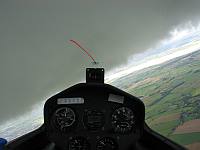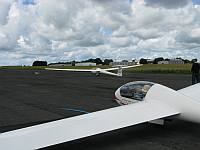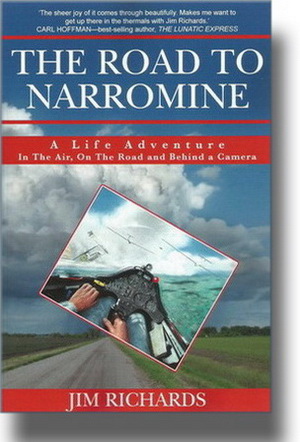
The Road to Narromine. What's it like to fly a sailplane? Read about film director Jim Richards' obsession.
What's it like to soar silently with the eagles? To direct TV commercials around the world? To broadcast from Bermuda? A memoir about the kind of life most just dream about.
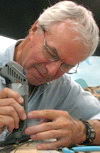 Film
director, Jim Richards, has had an extraordinary life. A director
for LucasFilm, a renowned model railway builder... he's done it all.
Film
director, Jim Richards, has had an extraordinary life. A director
for LucasFilm, a renowned model railway builder... he's done it all. With eloquence, optimism and wry humour, he takes the reader on a worldwide odyssey as a radio broadcaster, film director, driving enthusiast and obsessive sailplane pilot.
Learning to fly sailplanes (gliders) in Australia at age 39 was first a challenge for him, then an exultation. With a cameraman's eye for detail, he takes you into the cockpit. You're there at the controls, rising like a bird, flying long distances powered only by the sun.
A Buzzword eBook first release. $3.99. Use our secure shopping cart here:
Read an
incident from Narromine here:
1997
When a sailplane hits
power or communication wires, the almost-inevitable outcome is the death of
the pilot. The reason is simple. One of two scenarios rapidly unfolds.
In the first case, the wires slip over the finely pointed nose of the
sailplane and whip back along the top of the fuselage until they encounter
the vertical tail fin. The momentum of the sailplane, traveling at fifty
knots or better, causes the wires to shear the tail completely off the
aircraft, or to snap the tail boom a few feet forward of the tail. Deprived
of the stabilizing forces and balance of the tail assembly, the nose section
pitches forward and dives into the ground, either inverted, which kills the
pilot from a face-down impact, or vertically, which has the same terminal
result due to the heavy wing spars breaking loose and striking the pilot
with great force on the back of the head and neck.
In the second
instance, the wires pass under the nose of the sailplane. They zing back
along the belly until they hit the main wheel, which, since the pilot is on
final for a planned landing, is down. The wires then act like the arrester
cables on an aircraft carrier, except they're in the worst possible place,
low and forward, close to the aircrafts center of gravity. The sailplane is
effectively stopped dead in mid air, but its momentum causes it instantly to
rotate over the wires in a forward somersault and pitchpole into the ground
either upside down or nose first, with the same outcome for the pilot. In a
high percentage of accidents in which a sailplane has hit wires the pilot
has not survived.
Because I raised the AS-W 20s left wing to
execute a low-level turn to the right to line up with the furrows in that
paddock south of Narromine, I'm here today to write about it. If I had
continued straight and level, the wires would have zipped along the top of
the fuselage and, almost inevitably, chopped off the tail of the aircraft. I
would have pitchpoled in, with the results described above.
What
actually happened, though, was quite different. The wires came slicing back
over the canopy at fifty knots and encountered the raised left wing about
three feet from its root. The wing jammed the wires together, causing fat
short-circuit sparks that burned through the plexiglass just above my
head. The collision between wires and wing virtually stopped the aircraft in
mid-flight. My own body momentum caused me to slam forward into the
restraint harness, forcibly expelling the air in my lungs and whiplashing my
chin onto my chest.
From that moment, time seemed . . . to . . .
slow . . . right . . . down.
I pulled my head back upright, saw
the wires inches from my face and knew that I had suddenly become the main
ingredient in a recipe for an unexpected funeral. As my vision cleared, the
nose of the aircraft pitched up and up, rotating sharply to the left. I
instinctively jammed the stick full forward to try to bring the nose down.
There was a rasping, screeching sound. The wires, still sparking, were
sliding outward along the left wing, leaving pitted scorch marks. The
sailplane was actually traveling sideways to the right, away from the wires.
I tramped on full right rudder, knowing that at this point anything I might
do would probably be futile and that the aircraft (and my life) was in the
hands of those implacable forces, momentum and gravity.
At last
the nose started to drop. With a final jangle of sparks, the left wing slid
out from under the wires and the aircraft went into free fall, glissading
sideways and down, the nose still dropping, the ground coming up.
In the cockpit and around the aircraft itself, existence had turned into an
almost-normal-appearing dream world. The noise of crashing wires and popping
sparks had gone away. The slipstream rush was strangely missing. I was, for
the moment, unhurt. The wings and tail were apparently still attached. The
controls seemed to function. The aircraft was in a relatively conventional
attitude, right side up and slightly nose down, although the nose was still
dropping.
Two things were abnormal, however. The sailplane was
traveling absolutely sideways to the right, and the approach angle to the
ground was about twenty-five degrees - really steep for even a reasonable
facsimile of a walk-away landing.
It was at this moment that I
experienced, with crystal clarity, a startling hallucination. I was in two
places simultaneously. The cockpit, my hands and feet on the controls, my
chest struggling to suck in air, the ground rising alarmingly beneath. All
these things were etched sharply on my conscious physical senses. But, at
the same time, I was clearly and vividly on an operating table in a modern
surgery suite, blinking up at a barrage of stainless steel lights while
masked surgeons leaned over me, their eyes dark and grim. There in the
cockpit I felt with morbid dread that, in the next four or five seconds, I
was either going to die, or break my back.
On the hallucinatory
surgical gurney I sensed that my spine had indeed been broken and that I
faced a gruesome operation followed by a life of pain and paralysis. As the
sailplane fell toward the earth, I lay there semi-supine in the comfortable
nest of my sheepskin parachute liner, right hand thrusting the stick far
forward, right foot at full extension on the rudder pedal, convinced that it
would be one fate or the other, paralysis or death, not knowing which would
be the better to hope for.
The image of glaring lights, stainless
steel, and glittering eyes above green cotton masks flicked off. For a
fleeting moment I had a snapshot mental image of the aircraft straightened
out and executing a fairly normal straight-ahead landing.
Hah!
What was I thinking? I couldn't get this thing even to begin to yaw to the
right. The whole semi-airborne assembly was frisbeeing groundward at nothing
remotely resembling a normal flying attitude. The lack of adequate airspeed
prevented the tail from doing its weathervane job of turning the aircraft to
fly pointed-end-first, plus the entire side of the fuselage was presented to
the air mass, causing huge resistance and drag, further eroding what little
speed I had left.
This was not going to be a landing. It was going
to be a crash.
Here came the ground. The nose was pitched down now at
maybe forty-five degrees. I was moving sideways to the right at probably
thirty knots. Here were those damned furrows in the dry red soil, only eight
feet away, streaming across the nose and not lined up at all. There were
small stones and yellow blades of last years stubble tumbled in the mix. At
the last moment, like a paratrooper about to hit the ground, I retracted my
right leg from the rudder pedal and flexed my knees slightly.
The
nose struck with a tearing crash. I felt a violent jerk to the left in my
feet and legs. Dust billowed into the cockpit and pebbles clattered on the
canopy as the aircraft sheered around to the left. The right wingtip dipped,
touched, grabbed, and swung the aircraft counterclockwise in a fierce
backward groundloop.
Now the whole fuselage banged down with a
noise like a car crash. My head cracked into the canopy, driving the steel
cap button painfully into my scalp. Everything rushed backwards, bumping and
shaking. My legs were being thrown around in the nose, but my body and arms
were held in place by the restraint harness and by my death grips on stick
and airbrake handle while the hammering and shuddering went on, until
finally the aircraft ground to a stop in a rolling cloud of dust.
Then, silence.
Well, almost. The audio variometer on the
instrument panel still sang its muted no lift tone, weeeoooowwooeeee.
Of course there's no lift, we're on the fucking ground, damn it.
I
reached out and flicked the audio switch to OFF and took a gasping deep
breath.
Still alive!
I was encouched there in the
cockpit, facing back exactly the way I had come in. Red dust hung in the air
all around. As it sifted down, I saw the wires I had hit fifty yards back
whanging and jangling in the sunlight like a slack guitar. It would be
several minutes before their oscillations stopped.
Tentatively, I
moved my legs. They felt more or less normal. I looked down at my feet,
offset way over to the left in the nose of the aircraft. Small shafts of
sunlight streamed into the footwell. That wasn't normal. Christ, I've
damaged the iconic Uniform Kilo India, John Rowes former championship
aircraft. Rowe had retired and moved north to Queensland, but UKIs current
owner, Arnie Hartley, was very much in place at the Soaring Club in
Narromine. How would I confront him after this brutal violation? I would
have to face people to whom this AS-W 20 was a symbol, not only of Rowes
heritage and Arnies investment, but club income and soaring opportunities
for dues-paying members.
God damn.
But I'd have to deal
with all that later.
The canopy was sprung partly ajar. I reached
up to open it and saw my hands shaking. I unlatched the restraint straps and
parachute harness. By partly sitting up, I got enough purchase to heave the
creaking canopy up and away to the right. Heat and dust filtered into the
cockpit, together with the song of grasshoppers. Distant galahs squawked and
cackled in the eucalypts along the main road. With effort, I hoisted myself
in the seat pan and struggled to extract my legs from under the instrument
panel. My left foot seemed stuck, but, after pulling and twisting, it
wrenched free. I climbed stiffly over the left cockpit rim and stood up in
the sunshine on the dusty soil.
Alive and uninjured!
My
left ankle hurt, but that was nothing. I moved my arms and legs, tentatively
marching in place for three or four steps, flexing arms and shoulders,
twisting my spine. Nothing seemed broken. Everything worked. I felt as
though I should fall to my knees and kiss the dirt, or put my cheek on the
cool white gelcoat and weep in gratitude. Instead, I took two more deep
breaths, leaned into the cockpit where the radio still hissed its
white-noise song, pulled the mike stalk close to my mouth and pressed the
thumb switch on the control stick.

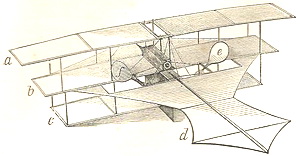
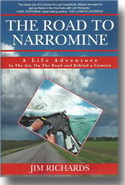 REVIEWS
OF
THE ROAD TO NARROMINE:
REVIEWS
OF
THE ROAD TO NARROMINE: